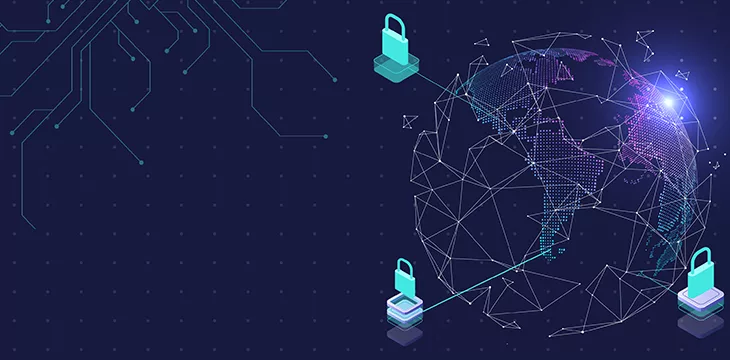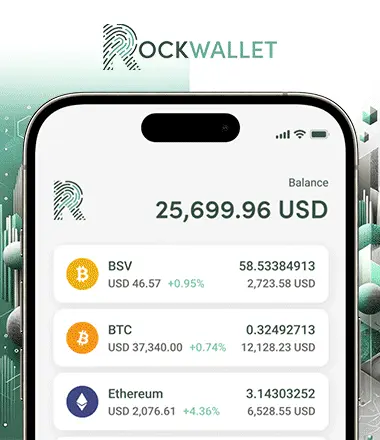As the world becomes increasingly interconnected through devices and the Internet, worries about data protection are at unprecedented heights. In fact, 90% of internet users agree that online privacy is a pressing concern. To address this unease, companies leverage blockchain‘s groundbreaking innovation regarding data protection and security in the Web3 era.
Simply put, blockchain revolutionizes how enterprises manage and protect consumer information during transactions. Here’s a comprehensive overview of the fundamental principles of Web3 and blockchain and how they safeguard data privacy in the digital era.

How Does Blockchain Secure Sensitive Data?
The following features of blockchain work together to create a secure and user-controlled environment that prioritizes data privacy.
-
Decentralization
Unlike traditional systems, blockchain operates on a distributed network of computers or nodes. Each node stores a copy of the blockchain ledger to ensure no single point of failure or vulnerability. The system is decentralized, meaning no single entity controls and manages stored data.
This feature also makes it difficult for malicious actors to defraud and compromise the system. Since blockchain spreads data across a vast network, gaining control over it is exceptionally challenging. An attacker must control most nodes to alter or compromise data, which becomes increasingly difficult as the network grows.
-
Cryptography
Blockchain heavily relies on cryptographic techniques to secure data at every step. It encrypts transactions and information, making them nearly impervious to unauthorized access and manipulation. Public and private keys serve as digital signatures that verify identities before granting access to data.
Moreover, blockchain’s cryptographic hashing ensures immutability. Each block in the chain contains a unique hash of the previous one to create a secure and tamper-proof link between them. Any attempt to alter data necessitates changing information in subsequent blocks, which requires computational resources.
-
Immutable records
Thanks to cryptographic hashing, data added to the blockchain becomes part of an unchangeable historical record. This feature is particularly valuable for data auditability relating to sensitive company correspondence, financial transactions, and legal contracts.
Ultimately, blockchain’s immutability safeguards information from fraud and unauthorized manipulation. Tampering with existing records immediately raises red flags within the network because cryptographic hashes would no longer match.
-
Consensus mechanisms
These mechanisms are operations by which blockchain networks assign participants to validate the ledger. Actors must reach a consensus before permitting any changes, providing an additional layer of security that all parties know.
For example, the Proof of Work (PoW) mechanism helps prevent spam and fraud by requiring participants to solve mathematical puzzles. Meanwhile, Proof of Stake (PoS) involves validators putting some of their assets into the network to prove their honesty, similar to collateral. These measures ensure that the blockchain only receives validated and legitimate transactions and data entries.
-
Encryption
Encryption is the cornerstone of blockchain technology when securing sensitive data. Information can be uploaded to the blockchain in plain text. The beauty of the blockchain is that encryption is optional, and whether data is public or private, its provenance is auditable without the data itself necessarily being decrypted.
It’s especially crucial for protecting sensitive information in public blockchains where everything is visible to all participants. Each user has private keys, which act as cryptographic signatures to access their data and authorize transactions. Without the key, encrypted information remains inaccessible, even if the hashes are visible to other participants on the blockchain.
-
Private and permissioned blockchains
Not all blockchains are equal in terms of access. While public blockchains allow anyone to become a participant, which means transactions and records are visible to everyone, private and permissioned ones restrict who can join the network. These variations are common among organizations requiring internal auditing and record-keeping.
Only trusted entities may share and validate transactions in private blockchains, ensuring data remains within a controlled and secured environment. Meanwhile, permissioned blockchains give access to authorized entities, so they’re less secure but more decentralized than their private counterparts.
-
Smart contracts
These practical applications of blockchain are self-executing agreements with terms written into code. They automate and enforce the execution of contractual agreements, eliminating the need for intermediaries while reducing the risk of disputes or fraud.
Smart contracts operating on blockchain networks have their terms and conditions visible to all parties in the agreement. You can encrypt data within a smart contract to keep sensitive details confidential. Then, they’re only accessible through cryptographic keys, so only authorized parties may interact with the document.
What is Web3?
Web3, or Web 3.0, is a new iteration of the World Wide Web. It incorporates decentralization and blockchain technologies to represent the next generation of the Internet, focusing on shifting power from companies to users. In other words, Web3 aims to make customer data private.
Historically speaking, Web 1.0 emerged in the 1990s as the first version of the Internet. It only covered the basics—searchable information from digital libraries and simple ecommerce—so it was mostly a read-only system. Big companies like Apple and Microsoft were already fetching user information to fuel their operations.
Web 2.0 rose to prominence in the 2000s and primarily until today. Unlike its static predecessor, this new version of the World Wide Web began using dynamic pages with user-generated content (UGC) for interactivity. Tech advancements have also made it easier for users to interact with others, consume content, shop online, and work within a few clicks and swipes.
However, data harvesting and analytics have also become a standard procedure among companies. It’s so prevalent that a 2021 report from KPMG revealed that 86% of consumers are concerned about data privacy, while 68% worry about the amount of data businesses collect from them. Fortunately, Web 3.0 resolves this problem by establishing a more secure user-centric system, and open protocols so that users can leave with their data and control how it is used.
User Control in the Web3 Era
The advent of Web3 would return complete ownership and control of your data to you, ushering in a new era of information security in the digital space.
1. Data sovereignty
Web3 technologies enable you to maintain control over your data and choose what information to share and with whom. Take blockchain, for example. You can store data and transactions within the network and encrypt them so only authorized individuals may interact. You can also grant and revoke access on a granular level to ensure your information remains private.
Data sovereignty also extends to monetizing personal data. You can share data with trusted entities and receive compensation, giving you more control over data usage.
2. Encrypted communication
In the traditional Internet, correspondence is often vulnerable to interception and surveillance. This scenario raises concerns about the confidentiality of personal conversations and sensitive information. However, Web3 emphasizes the importance of encrypting communication to protect user privacy.
How does it work? No platforms or services own Web3 messaging. Instead, it operates on a peer-to-peer network built on blockchain technology, allowing you to communicate with others without needing an intermediary. It would also utilize end-to-end encryption and decentralized storage to improve security and control over messaging data.
3. Trustless transactions
Web3 introduces the concept of trustless transactions, where you may interact, transact, and contract without relying on traditional, centralized intermediaries. This is possible thanks to smart contracts, which automatically execute when concerned entities meet the agreement’s predefined terms. As such, there won’t be much need for third parties, like banks and legal institutions, to minimize fraud.
It’s a common practice in decentralized finance (DeFi), where you can transact without mediators. Ultimately, Web3 offers greater control over your assets and financial decisions by leveraging blockchain technology and trustless ecosystems.
How to Secure and Protect Your Data in the Web3 Era
The following practices let you secure and protect your data as Web3 technologies become more prevalent in the digital landscape.
1. Know how your data is used
Knowledge is power—understanding how companies use your information is fundamental to data security. Review the privacy policies of websites and services you use to discover how they collect, process, and share your data with third parties. You could also support platforms that are transparent about their data collection practices to encourage other companies to follow suit in terms of data security.
2. Learn the value exchange for your data
Your personal information, browsing habits, and preferences are valuable assets in the digital economy. As mentioned, you have more opportunities to control and monetize this information, but you still have to do it safely. Start by investigating operations allowing these transactions; some blockchain-based services provide a platform where individuals and companies freely buy and sell data.
3. Check how businesses protect user privacy
An organization’s data-related operations indicate whether they prioritize data protection. Check whether the business you’re interacting with employs robust security measures like encryption, access controls, and regular audits. Data minimization, or the practice of collecting only the data necessary for their operations, is an excellent way to determine a company’s commitment to data privacy.
4. Stay on top of new Web3 developments
The Web3 landscape is constantly evolving. As the digital world gradually embraces its principles within the next few years, staying updated on its latest developments, technologies, and trends is essential. Then, you can decide which platforms and services to trust with your data.
Safeguard Your Data in the Web3 and Blockchain Era
Ultimately, Web3 promises complete control of one’s privacy and online identity. Meanwhile, blockchain is ready to take the Web3 era by storm, securing and protecting data in new ways.
If you want to know more about blockchain, CoinGeek is the perfect resource for you. Head over to our guide on blockchain for beginners to learn more about this emerging tech. In our latest piece, we talked about Bitcoin Schemas such as B, MAP, BMAP, 1Sat Ordinals, and JungleBus as ways to completely deploy such a Web3 system and maximize an HTML-like publisher to Bitcoin.

 06-30-2025
06-30-2025 



